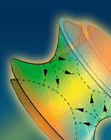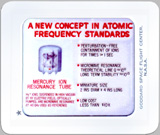

![]()
![]()
![]()
![]()
![]()
![]()
![]()

The
author.
An early presentation slide used by the author at NASA/Goddard around 1971 to promote a new concept in atomic clock design
|
F.G. Major Now a leading authority on atomic clocks, F.G. Major began his career in 1949 with an undergraduate degree from the University of New Zealand, where, for his M.Sc. thesis he designed and built an experimental digital sequence control unit to operate a Wilson Cloud Chamber. Following a teaching post at The American University of Beirut, In 1962 he earned a PhD in Physics at the University of Washington, Seattle, working with Prof. Hans Dehmelt on radio frequency spectroscopy of He ions using the Paul ion trap. Having completed his Post-Doctoral work at Yale with Vernon Hugh's group, he joined Gernot Graeff's team at the Physikalisches Institut, University of Bonn, at the invitation of Dr. Prof. Wolfgang Paul, where he did research on magnetic resonance spectroscopy of free electrons. In 1967 he joined Andy Chi in the Advanced Development Division at NASA/Goddard Space Flight Center, where he did the basic research on mercury ions as the basis for a new spacecraft mercury ion frequency standard. His seminal article on the observation of ultra-narrow resonance in the microwave spectrum of field-confined mercury ions was published in 1972 in the Physical Review Letters. Leaving NASA in 1973, he continued his work on the optical pumping of ions in collaboration with the Audoin group at the Laboratoire de l'Horloge Atomique at Orsay. As an educator, in 1977 Major accepted a professorship in the Physics Department of the University of Kuwait, where he helped establish a modern physics student laboratory and a laser atomic spectroscopy research laboratory, first applied to the radiative lifetime of atomic states in calcium. He returned to The Catholic University of America as Visiting Professor in 1989, and collaborated with Herbert Ueberall in developing theoretically a polarimetric technique for the study of laser scattering from small particles. In 1994 began work on The Quantum Beat, which was published by Springer-New York in 1998. This second edition was published in June 2007.
|
